
Trotsky and Other Revolutionaries in New York
Revolutionaries in New York
New York City has seen its share of revolutionary figures. Some were people we would label "revolutionary" because of their innovative art, like Edward Hopper or Andy Warhol, or their writing, like Edgar Allan Poe or H. P. Lovecraft or Hunter S Thompson. But some have been literally revolutionary, like Leon Trotsky, a major figure in the Russian Revolution who was exiled to the U.S. for a few months during which he lived in the Bronx and worked at a communist newspaper in the East Village. Or the anarchists who perpetrated a series of dynamite bombings including what was, in 1920, the deadliest act of terrorism in the history of the U.S. Or the Catholic Worker movement, which was founded on the Lower East Side in the 1930s.
Leon Trotsky in New York
Лев
Троцкий
в
Нью-Йорке
Leon Trotsky
Leon Trotsky, born in Ukraine, was one of the leaders of the Communist Revolution and the founder of the newspaper Pravda. The revolutionary life can be a difficult and even dangerous one. He was arrested and exiled into Siberia twice during Tsarist days. He was in western Europe working as a journalist when World War I broke out, going first to Switzerland to avoid arrest by Austria-Hungary. He moved on to France, which deported him to Spain because of his anti-war activities. Spain soon deported him to the U.S., where he lived and worked in New York for a few months. He returned to Russia after the February Revolution of 1917 overthrew Tsar Nicholas II.
By the end of 1917 he was second only to Lenin in the leadership of the Bolshevik Party, and so he was very influential in the newly formed Soviet Union. But in the power struggle after Lenin's death in 1924, Stalin portrayed Trotsky as an enemy of the party and sent him into exile. He spent a year in Kazakhstan, four years in İstanbul, two years in France, two years in Norway, and finally ended up in Mexico City where he lived with the painters Diego Rivera and Frida Kahlo and then moved into a house of his own nearby. Just over a year later, one of Stalin's assassains killed him with an ice ax.
Trotsky was born Лев Давидович Бронштейн or Lev Davidovich Bronshtein in Yanivka, Ukraine, in 1879. He changed his name during Czarist days to Lev Trotsky, with Троцкий or Trotsky derived from Trotz, the German word for "defiance". For some reason we English speakers usually replace his native and actual name Lev or Лев with Leon. See the same sort of thing with the author Лев Николаевич Толстой, who we call Leo Tolstoy.
Symbolic name changes were a big thing with the Bolshevik revolutionaries. Vladimir Lenin was originally Vladimir Ilyich Ulyanov. In 1870 he attempted to illegally publish the newspaper The Workers Cause and the Tsar exiled him to Siberia, near the Lena River. Vladimir adopted the pseudonym Lenin, based on the river's name. Iosif Stalin or "Joe Steel" was born with the unwieldy Georgian name Ioseb Besarionis Dze Jugashvili.
Trotsky's father was a well-to-do farmer who sent his son at the age of nine in 1888 to Odessa for schooling. Odessa was a cosmopolitan port city, very atypical of the Russian Empire. The atmosphere of Odessa led Trotsky to adopt an international outlook.
In 1896, when he was just sixteen, Trotsky had moved from Odessa to Nikolayev and become involved in revolutionary activities. He was initially a народник or narodnik, a populist revolutionary. He was introduced to Marxism, a philosophy which he initially opposed but then gradually came to adopt.
Trotsky helped to organize the South Russian Workers' Union in Nikolayev in early 1897. Two hundred members of this union, including Trotsky, were arrested in January 1898. Trotsky was imprisoned for two years waiting for his trial. During this time the Russian Social Democratic Labor Party was formed. Trotsky became a member of this party, he married fellow Marxist Aleksandra Sokolovskaya, and he studied philosophy. He finally got his trial in 1900, at which he and his wife were sentenced to four years of exile in the Irkutsk region of Siberia.
Leon and Aleksandra had two daughters in Siberia, but they soon separated and divorced. Meanwhile the party was splitting into factions. One side argued that the party should concentrate on improving the lives of industrial workers. The other, which Trotsky sided with, said that the most important thing was forming a well-organized and disciplined revolutionary party with which to overthrow the monarchy.
Trotsky escaped from his exile in Siberia during the summer of 1902. He moved to London to join the editors of Искра or Iskra, the newspaper of the monarchy-overthrowing faction. Trotsky took the pen name Перо or Pero (meaning feather or pen), becoming one of the paper's leading editors along with Vladimir Lenin, Georgi Plekhanov and Julius Martov. Trotsky met Natalia Ivanovna Sedova in late 1902. She soon became his lover, and they married in 1903.
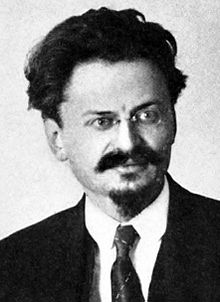
Leon Trotsky in 1921.
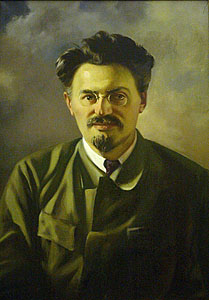
Official Soviet portrait of Leon Trotsky.
No one should ever claim that left-wing political movements are simple. They split and squabble in a fractal fashion. The six editors of Iskra were equally split between Plekhanov's "Old Guard" and Lenin and Martov's "New Guard". Lenin expected Trotsky to side with his "New Guard" and give it a majority. So, Plekhanov opposed making Trotsky a full member of the editorial board.
In 1903, Iskra convened the party's 2nd Congress in London. Soon after that the pro-Iskra group split into two factions. Lenin's Bolsheviks wanted a smaller but highly organized party, while Martov's Mensheviks wanted a larger and less organized one. In case you aren't confused yet, the name bolshevik or большевик refers to larger size while menshevik or меньшевик refers to smaller size — the opposite of those factions' desired party sizes! But the idea was that большевик or bolshevik referred to the "majority" and меньшевик or menshevik referred to the "minority". Meanwhile most of the Iskra editors (the majority!), including Trotsky, sided with the mensheviki. For a recent example of political abuse of language and logic, see the American right wing's confusing insistence that they're a Moral Majority.
Trotsky gave up on this confusing mess in September 1904 while the Mensheviks were insisting on an alliance with Russian liberals and opposing reconciliation with Lenin and his Bolsheviks. Trotsky described himself as a "non-factional social democrat" from 1904 until 1917, during which he spent most of his time trying to reconcile the various factions within the party. In his spare time he was developing his theory of Permanent Revolution.
In January 1905 a group of unarmed demonstrators were marching through Sankt-Peterburg to deliver a petition to Tsar Nicholas II. The petition called for improved working conditions, a reduction of the working day to eight hours, and increased wages, along with an end to the Russo-Japanese War and the introduction of a universal right to vote. They were approaching the Winter Palace from several directions when they were gunned down by the Imperial Guard in the Bloody Sunday massacre.
Maybe about 1,000 people were killed — the Tsar said just 96, anti-Tsarist sources said over 4,000 — and disorder and looting broke out. This led to the Revolution of 1905, which would in turn lead to the 1917 Revolution.
Trotsky returned to Russia in February, the month after Bloody Sunday, initially writing pamphlets for an underground press in Kiev but soon moving to Sankt-Peterburg. He worked there with both Bolsheviks and Mensheviks. However, the Mensheviks were infiltrated by a secret police agent. This forced Trotsky to flee to rural Finland until a national strike in October 1905 allowed him to return.
The Mensheviks had come up with the same idea Trotsky had, a Soviet or Совет (or "Council") of Workers, an elected non-party revolutionary organization. The Sankt-Peterburg Soviet was up and running by the time Trotsky returned from Finland. Trotsky joined the Soviet and was elected its Vice-Chairman under yet another pseudonym, "Yanovsky". The chairman was arrested in November, and Trotsky took his place.
On December 2, 1905, the Sankt-Peterburg Soviet issued a proclamation criticizing the Tsarist government. To no one's surprise, the Soviet's office was promptly surrounded the next day by troops loyal to the Tsar's government. Trotsky and other leaders of the Soviet were arrested and then tried in 1906 on charges of supporting armed rebellion. Trotsky delivered what are considered to be some of his best speeches at his trial, but he was convicted and sentenced to deportation and exile in Obdorsk, Siberia.
While on the way to Siberia in January 1907, Trotsky once again escaped. He made his way to London, arriving in time to attend the 5th Congress of the RSDLP (or Russian Social Democratic Labor Party). In October he moved to Vienna for what ended up being seven years, an unusually long time of stability for Trotsky. While in Vienna he participated in both the Austrian Social Democratic Party and the German Social Democratic Party.
In October 1908 Trotsky founded the newspaper Правда (or Pravda), whose name meant Truth. Pravda became a party-financed "central organ" in 1910, and Trotsky kept publishing it until April 1912. The very same month, the Sankt-Peterburg Bolsheviks started a new labor-oriented newspaper and also called it Pravda. This co-opting of the name greatly upset Trotsky. He sent a letter to the Mensheviks denouncing the newspaper-title-stealing Bolsheviks in general and Lenin in particular. Unfortunately, the police intercepted the letter and kept a copy in their archive. The letter was found in the archive in 1924, soon after Lenin's death, and it was used to portray Trotsky as an enemy of Lenin.
Trotsky continued to write articles for radical Russian and Ukrainian papers. These included Kievskaya Mysl, which in 1912 sent him as their correspondent to cover the two Balkan Wars.
World War I broke out in late July of 1914 after the assassination in Sarajevo of Archduke Franz Ferdinand of Austria. This eventually globe-spanning conflict pitted Austria-Hungary against the Russian Empire, and so within a week Trotsky had to flee to neutral Switzerland to avoid arrest in Vienna as a Russian. Once there he worked with the Swiss Socialist Party and quickly cranked out an anti-war book, The War and the International.
He moved on to France in November 1914 as a war correspondent for the Kievskaya Mysl. In January 1915 he began editing Наше Слово or Nashe Slovo, "Our Word".
The French put up with Nashe Slovo and Trotsky's anti-war activities for just three months. At the end of March they deported Trotsky to Spain. The Spanish didn't want him either, although they let him stay for over a year and a half. Around Christmas of 1916 they deported Trotsky to the United States.
Trotsky in New York
Trotsky arrived in New York on January 13, 1917. He was there for not quite three months. He lived in the Bronx, at 1522 Vyse Avenue.
Take the #2 or #5 train to Freeman Street. Walk a block and a half east to Vyse. Turn south and walk two long blocks south to #1522, on the corner where Vyse crosses East 172nd Street.
This is a "site-of" now. The Mildred, the building you see today on the corner of Vyse Avenue and East 172nd Street, was constructed in 1931. It replaced whatever tenement Trotsky occupied during his New York exile in 1917.
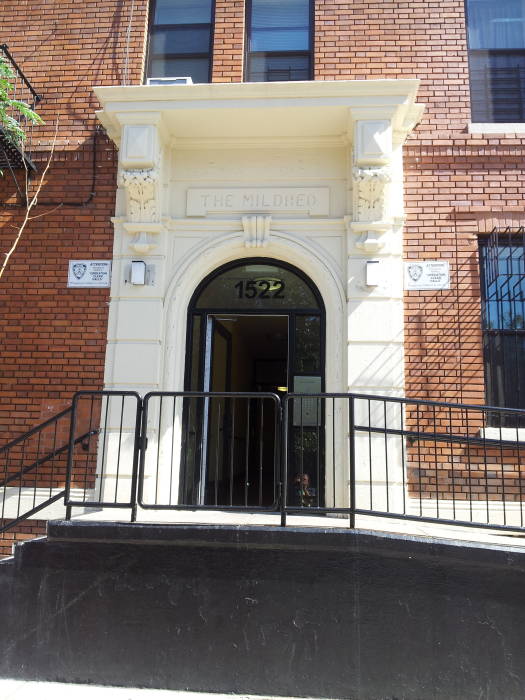
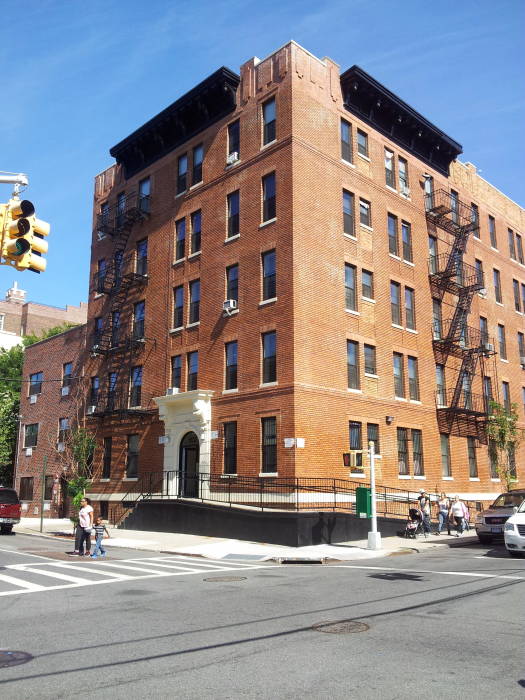
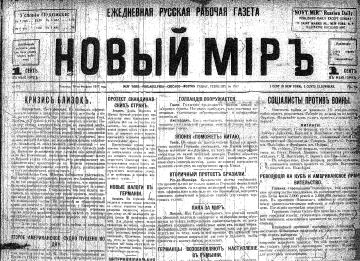
Новый Міръ front page, Friday, February 16, 1917
Trotsky worked for Новый Міръ or Novy Mir (that's New World in English), where he worked alongside Nikolai Bukharin and Alexandra Kollontai. Bukharin went on to be a member of the Politboro and Central Committee of the Soviet Union, and editor in chief of Pravda (the post-revolution Soviet one), Bolshevik, Izvestia, and the Great Soviet Encyclopedia. Then he opposed a number of Stalin's policies and fell victim to the "Moscow Trials" and purges of the late 1930s.
Notice the spelling of the paper's name, it uses the pre-revolutionary Міръ instead of the sleek revolutionary Мир.
St Marks Placein the
East Village
Trotsky also wrote articles that were translated into Yiddish for publication in Der Forverts, "The Forward", a Yiddish radical publication.
Novy Mir was published at #77 St Marks Place in what today is called the East Village. St Marks Place is east 8th Street, it's one of the small set of numbered streets with a name.
Today, #77 St Marks Place is the home of La Palapa, a nice Mexican restaurant. #77 is the lighter colored building toward the right in this picture, the yellow and red extension is the entry to La Palapa.
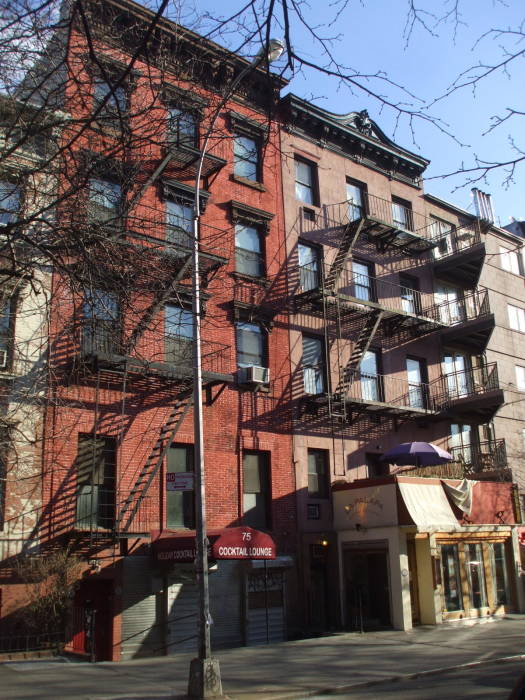
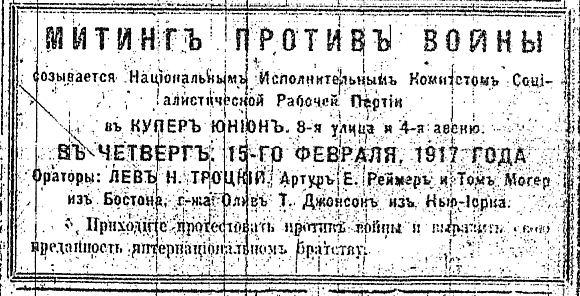
This notice in Novy Mir announced a meeting against the war. It was held at Cooper Union, at 8th Street (or St Marks) and 4th Avenue, on the 15th of February, 1917. The first "orator" or speaker, listed in all capitals, is Lev N. Trotsky.
Trotsky Returns to Russia
Russia's February Revolution of 1917 overthrew Tsar Nicholas II, and Trotsky left New York by ship on March 27th. He reached Russia on May 4th and joined the Mezhraiontsy, a regional social democratic organization in Sankt-Peterburg. The city was also known as Petrograd around this time. He was elected a member of the first All-Russian Central Executive Committee (ВЦИК or VTsIK) at the First Congress of Soviets in June.
Trotsky was arrested, again, after an unsuccessful Bolshevik uprising in August. He was held for 40 days and then released. The Bolsheviks then gained the majority in the Petrograd Soviet, and Trotsky was elected the Bolshevik party chairman on October 8th.
By the end of 1917 Trotsky had clearly become second only to Lenin in the Bolshevik Party.
Stalin wrote a summary of Trotsky's role in the events of 1917. This piece was published in Pravda and included in Stalin's 1934 book The October Revolution, but then it was cut out of Stalin's Works of 1949:
All practical work in connection with the organization of the uprising was done under the immediate direction of Comrade Trotsky, the President of the Petrograd Soviet. It can be stated with certainty that the Party is indebted primarily and principally to Comrade Trotsky for the rapid going over of the garrison to the side of the Soviet and the efficient manner in which the work of the Military Revolutionary Committee was organized.
The Bronx Home News was more straightforward with their headline:
RUSSIAN REVOLUTION
Trotsky was named the People's Commissar for Foreign Affairs. He resigned that position on March 13th, 1918, to become People's Commissar of Army and Navy Affairs and the chairman of the Supreme Military Council. The position of military commander-in-chief was abolished, granting Trotsky full control of the Red Army subject only to the oversight of the Communist Party leadership.
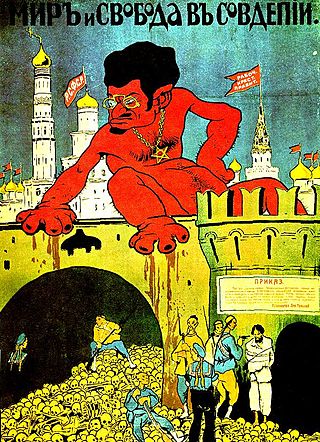
This White Army propaganda poster depicts Trotsky as Satan wearing a pentagram. It xenophobically portrays the Bolsheviks' Asian supporters as mass murderers. The caption reads, "Peace and Liberty in Sovdepiy".
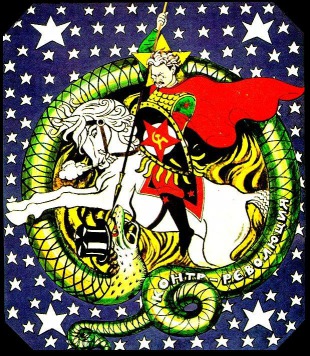
Trotsky as Saint George. This 1918 Bolshevik propaganda portrait depicts Trotsky as a modern-day Saint George slaying the dragon, which happons to be wearing a western-style top hat with the word "counterrevolution" written on its body. With some irony, given Trotsky's family background and his staunch non-religious stance, this also refers to Russian Orthodox Christian iconography of Saint George slaying the dragon, a very popular theme in the Russian church.
Trotsky was a party theorist and he seems to have been closer to the original intent of Marx than any other prominent Bolshevik figure. Lenin probably would have named Trotsky as his successor.
However, Lenin had three strokes between May 26th, 1922 and March 10th, 1923. These caused paralysis and loss of speech, denying him the ability to transfer leadership to Trotsky. Lenin died on January 21st, 1924. Stalin, Zinoviev and Kamenev formed a troika to make certain that Trotsky would not succeed Lenin, despite his official public position as second only to Lenin.
Then they pulled that unfortunate 1912 letter out of the archives. Trotsky lost all his official positions and political power in 1925. He was then expelled from the Central Committee in October, 1927, and soon after that, expelled from Russia.
Trotsky was initially exiled to Alma Ata in Kazakhstan on January 31st, 1928. Just over a year later, in February 1929, he was expelled from the Soviet Union to Turkey. Trotsky and his wife and son lived on the island of Büyükada near İstanbul for four years.
French Prime Minister Édouard Daladier offered Trotsky asylum in France in 1933. Trotsky moved there from Turkey and lived in Royan and Barbizon. But in 1935 the French authorities told him that he was no longer welcome in France. He lived near Oslo, Norway for two years, at which point he was put under house arrest. Norwegian officials arranged his transfer to Mexico by cargo ship.
Trotsky in Mexico
Mexican president Lázaro Cárdenas welcomed Trotsky when the cargo ship docked at Tampico. Cárdenas then arranged for a special train to carry Trotsky to Mexico City.
Trotsky initially lived at the home of the painter Diego Rivera and his wife Frida Kahlo. Trotsky had an affair with Kahlo, which led unsurprisingly to Rivera kicking Trotsky out of his house. Trotsky moved in May 1939 to a house a few blocks away on Avenida Viena.
Trotsky's Homein Mexico City
Meanwhile, in 1936 the first "show trial" had been staged in Moscow. Zinoviev, Kamenev, and over a dozen others had "confessed" to having joined Trotsky in a plot to kill Stalin and other Soviet leaders. They were all found guilty and sentenced to death, the sentence was passed on Trotsky in absentia.
A second "show trial" in 1937 of seventeen others connected Trotsky to more supposed conspiracies and crimes. Trotsky was now under a death sentence.
In May of 1940 a group organized by NKVD deputy director Pavel Sudoplatov launched an assassination attempt. The group was led by GPU agent Iosif Grigulevich, the Mexican painter David Alfary Siqueros, and Vittorio Vidale. They disguised themselves as police officers and overpowered Trotsky's guards. They set up machine guns in the inner courtyard of the home and began firing. Everyone inside hid underneath bedroom furniture as the attackers fired into the various rooms of the house. Trotsky's grandson was shot in the foot, and Robert Sheldon Harte, one of Trotsky's assistants and bodyguards, was abducted and later killed. The other guards eventually repelled the attack.
Ramón Mercader, a Spanish-born NKVD agent of Stalin's, was living in Mexico City with a Canadian passport. He had gone through a series of identities including "Jacques Mornard", a Belgian; "Frank Jacson", a Canadian; and "Jacson Mornard", who may have been Belgo-Canadian for all I know. He had managed to become the lover of Sylvia Ageloff, Trotsky's personal secretary, living with her on and off over a period of two years and gaining access and trust within the Trotsky household.
Leonid Eitingon, a GPU agent who had operated in Spain, planned a second attack. Mercader, as either Frank Jacson or Jacson Mornard, started meeting with Trotsky in the guise of a sympathizer.
On August 20, 1940, Mercader showed up at Trotsky's house with a mountaineering ice axe hidden under his coat. Why an ice axe? Because you can casually walk around Mexico City carrying an ice axe and no one will notice? That can't be it. Because Mercader was an expert with ice axes? That doesn't seem to have been the case, either.
Eitingon and Mercader's mother, Caridad, were waiting outside behind the wheels of two getaway cars. Nothing like joining forces with your mother in an assassination.
Mercader went into Trotsky's study and asked him to read something that he had written. While Trotsky was reading, Mercader pulled the ice axe out from under his raincoat and hit Trotsky in the back of the head. Perhaps due to Mercader's lack of experience swinging ice axes, the blow did not kill Trotsky immediately.
There was a struggle. Trotsky's bodyguards nearly killed Mercader but Trotsky told them not to, saying that the assassin should be made to answer questions. Trotsky was taken to the hospital, where he died the next day from blood loss and shock. The getaway drivers had gotten away, and both fled the country.
Mercader was convicted of murder and spent twenty years in prison in Mexico. He and his mother were awarded the Order of Lenin in absentia by Stalin. Mercader was released from prison in 1960 and moved first to Havana, Cuba, and then moved on to the Soviet Union in 1961. He was then awarded the USSR's highest decoration, Hero of the Soviet Union.
If you're really into Leon Trotsky ephemera, and you would like to also see pictures of his typewriter, his kitchen, his rabbit hutches, his sombrero, and lots more at his Mexico City home, then see my page with more pictures from there.
As for the Trotsky family, his great-granddaughter Nora Volkow became the head of the U.S. National Institute on Drug Abuse. She grew up in the Trotsky house in Mexico City.
Back to the Travel Recommendations